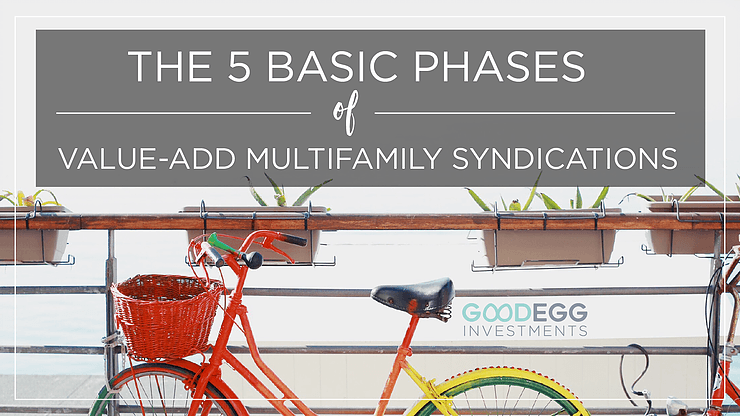When you first hear about value-add real estate investing, it’s apt to make your head spin. Especially if you’re new to the real estate syndication space or if you’re just barely learning about this real estate investment strategy. It’s okay, let me explain more about value-add investments and the process the investment property endures.
Beyond just acquiring real estate properties and expecting eventual appreciation, value-add properties allow real estate investors to take a little more risk, pursue renovations in a controlled effort to add value to the asset, and then sell after the capital improvements successfully increase rents.
As you can imagine, performing renovations to add value to a multi-hundred unit apartment complex could be quite complicated! Well, never fear because this value add real estate investment strategy is performed meticulously, one unit at a time, adding value to the property in a structured way that affects occupancy rates very little.
To provide a simple analogy, think back to elementary school with me. I remember the first time I learned about the five-paragraph essay in elementary school. Prior to that point, the focus of my writing had been spelling the words correctly, remembering which words were supposed to be capitalized, and trying to remember to use commas sometimes, whatever the heck they were for.
The five-paragraph essay brought a whole new level of structure to everything. It gave me a framework with which to organize my thoughts, not just my words. Start with a central idea, expand on it with three supporting paragraphs, and close with a strong conclusion.
Once I got the hang of it, the five-paragraph essay gave me the freedom and structure to communicate clearly and effectively. This is much like the value add investment strategy used by successful real estate investors!
Breaking Down One Of The Most Lucrative Real Estate Investment Strategies: Value-Add Multifamily Syndication
Similar to the way we were taught to write a proper five-paragraph essay, each value add real estate syndication (i.e., group investment) goes through a logical progression of stages. Not every syndication uses the same structure, but all good value add projects should have a clear beginning, middle, and end.
When you’re investing in other types of assets, like stocks and mutual funds, you’re doing so on your own, so you can determine when to buy, sell, or trade. When you invest in a syndication, on the other hand, it’s a group investment, so you’re pooling your resources together with a group of other multifamily investors.
That means that everyone has to be in sync in order for the investment to work. And that’s why it’s so important for value add investments to have a clear business plan.
In this article, let’s explore the five most common phases of a value-add multifamily real estate syndication:
- Acquire
- Add value
- Refinance
- Hold
- Sell
Phase 1 – Acquire Commercial Real Estate
The first stage of this opportunistic investment strategy is the acquisition of the asset. During this phase, a bunch of things happen. It’s a busy and exciting time for the syndication, as this phase sets the entire investment on the right foundation.
Buy Property
The acquisition phase starts with the sponsors getting a real estate property under contract. This can be one of the toughest parts of the core real estate strategy, as it can be very difficult to find a great value-added property, and when you find one, it can often involve a competitive offer situation.
This means that the sponsors have to really be on top of their game in order to get a property under contract in the first place. They have to have strong relationships with the real estate brokers in their market in order to get access to the best deals.
They have to have impeccable underwriting skillz, so they can quickly and accurately determine whether a deal is worth pursuing. They also have to have strong relationships with lenders and property managers, to confirm their underwriting assumptions and to determine whether they can achieve their target projections on any given project.
Perform Due Diligence
Once the deal is under contract, sponsors shift their focus to due diligence. During this stage, sponsors must be incredibly thorough, leaving no stone unturned. It’s their job to find exactly what’s wrong with the property, update their assumptions, and adjust their business plan throughout, to ensure that their projections still work.
Find Investors
Once the sponsors are sure that the value add property is a solid investment, and that they can meet their projections with a reasonable level of certainty, the investment opportunity opens to potential investors.
This is the point in the process when we typically send out a new deal alert, along with the investment summary. Following that, an investor webinar helps investors learn all about the property’s untapped potential from the sponsors themselves.
After commitments are made and funds are wired in, the deal is ready to close. And champagne corks are ready to be popped.
Dig Deeper: A Closer Look At Multifamily Asset Classes
Phase 2 – Real Estate Value Add Process
The next phase in a value-add multifamily real estate syndication is the part where the value is actually added to the investment property. Often, the business plan calls for the renovations to start at full blast immediately upon closing.
This starts with a transition of the property management team if needed. Operational enhancements are often a quick-win when it comes to reducing operational expenses, increasing efficiency, and thus, increasing the property’s net income. Then, the renovations begin, most often with the vacant units first.
Based on the property and the business plan, renovations may also include exterior and common area renovations, such as updating light fixtures, adding a dog park, adding covered parking, cleaning up the landscaping, sprucing up the pool area, and more.
Typically, this phase of the investment can last anywhere from a few months to a few years. In a heavy value-add investment, where most, if not all, the units need to be updated, the unit renovations can take 12 to 18 months or longer.
Renovations typically start with the vacant units. Then, as leases come due, those tenants have the opportunity to move into the freshly renovated units (and most of them are ecstatic when they see the stainless steel appliances and new countertops) at market rents. Renovations then continue in the units the tenants vacate, and on and on until all the units get updated.
Phase 3 – Refinance If It Benefits the Real Estate Investors
Once the intended updates and renovations are complete, hopefully, the property is now generating significantly more revenue. This is a big deal.
How Commercial Assets Are Valued
Why? Because, remember the difference between how to determine the value a single-family home versus an apartment building?
With a single-family home, you look at comps (i.e., other single-family homes that have sold recently in the area). It doesn’t matter if you just put a ton of money into a new kitchen remodel. If the house next door just sold for $300,000, your house will likely be worth about the same.
With a commercial asset, however, the valuation is based on how much money the asset generates, so higher rents significantly increase the value of the property.
In the case of value-add properties, as the units are renovated, they’re able to fetch a rent premium. For example, whereas an existing unit might rent for $800, a unit with interior upgrades might rent for $900.
I get it. This $100 may not seem like much. But, think about it this way. An additional $100 a month is $1,200 per year. And that’s just for that single unit. If the apartment complex has 100 units, that’s an additional $120,000 per year in rental income across the whole value add property.
Plus, when you work in some underwriting and cap rate magic, that $120,000 per year in additional revenue equates to roughly $1,200,000 in additional equity. Roughly.
Aim to Refinance
That’s why, once the majority of the value is added into the property, and cash flow is increasing, sponsors will often seek a refinance. Unless interest rates are lower than when the property was acquired, a refinance on value add real estate is often done through a supplemental loan, so as to keep the original loan in place.
Based on the new revenues, the property will likely receive a higher appraisal value. A supplemental loan can then be put in place for that additional equity, which means investors get a chunk of their original capital returned.
For example, if you invested $100,000 into a value-add multifamily syndication, and, after 18 months, the sponsors refinanced the property and returned 40 percent of investor capital, that means you would receive $40,000 of your original capital back after just 18 months.
But here’s the kicker. Even though you get $40,000 back, you’re still receiving cash flow distributions as is your entire $100,000 were invested. That’s right, you get $40,000 back in your pocket, and you’re still getting eight to ten percent of $100,000 per year in cash-on-cash returns. #mindblown
Refinances Are Not Guaranteed
This is the power of a value-add investment. Keep in mind, though, that a refinance is not a guarantee. Many sponsors don’t even discuss a refinance in their business plan, as it’s more of an ace up the sleeve.
It’s great if it can happen, but, because there are so many factors at play in a value-add situation, there’s absolutely no way to guarantee when a refinance will happen, if at all.
In some situations, if the market is strong, and if the sponsors receive significant interest, the sponsors may choose to go ahead and sell the property early, rather than refinance.
Again, this is dependent on the property and the value-add investment strategy. Either way, when a refinance or sale happens, it’s time to pop those champagne corks again! Or is it ???
Phase 4 – Holding Period
The next phase of a value-add multifamily real estate syndication is to hold the value-add real estate asset while collecting cash-on-cash returns (aka, cash flow).
The length of this hold period can vary, based on the individual property, sponsor, and business plan.
A typical projected hold period for many of the investments we offer our investors is around 5 years from acquisition to final sale.
Stay the Course
This phase is probably the lowest risk phase of the entire process. The heavy lifting of the value-add renovations is done by this point, so there are very few, if any, unknowns at this point. At this stage, the goal is just to stay the course. Continue to increase the tenant base, explore ways to increase the property’s net operating income, and continue generating strong revenue.
Continued Appreciation
As the real estate property is held, it typically continues to appreciate in value, albeit more slowly than through the forced equity of repositioning or adding value to the property. Each year, rents are typically raised by a nominal two to three percent, thus continuing to nudge up the revenue that the property generates and contributing to the appreciation of the asset.
Phase 5 – Sell To Complete The Full Cycle
The final phase of a value-add multifamily real estate syndication is to sell the asset. At this point, the intended updates have been made, revenues are up, and the asset has appreciated in value.
Why Sell
Rather than hold the asset forever, the best use of real estate investor capital at this point is to sell the property and return investor capital, so that it can be invested into another project, to continue making that money work hard.
Disposition Process
During the disposition phase, sponsors work closely with the real estate broker and property management team to prepare the asset for sale. Sometimes, if it makes sense, the asset is sold off-market. This creates the least amount of disruption for existing quality tenants.
Other times, the sponsors go through the whole process of listing the asset, which, just like the acquisition phase, can be a ton of work.
Either way, once the sale is complete, you get your original capital back, plus a percentage of the profits.
1031 Exchange
In certain situations, when it makes sense, and when the majority of investors agree, the sponsors will initiate a 1031 exchange. This allows them to roll the proceeds of the sale into another investment, without having to pay capital gains taxes, which is always a win in my book.
For real estate investors, this allows you to keep your money invested and to continue with this same sponsor, but in a new value-add real estate deal. Some investors have done this through several cycles with a single sponsor and absolutely love it.
What A Value Add Real Estate Investment Strategy Really Means
So there you have it. Just like a five-paragraph essay, the five phases of a value-add real estate syndication give structure to the investment, let investors know what to expect, and allow the sponsors to focus on the work at hand.
During the projected hold time of a value add real estate syndication, the property will typically go through these five phases:
- Acquire
- Add value
- Refinance
- Hold
- Sell
Remember, not every value add property will go through all five phases. However, this is a fairly common structure that’s used by many value-add multifamily syndicators.
As a passive investor, you don’t have to lift a finger in any of these phases. However, it’s important for you to understand the arc of value add real estate, so you know what to expect and can make sure that the sponsors have a clear plan for the property, and for your hard-earned money.





